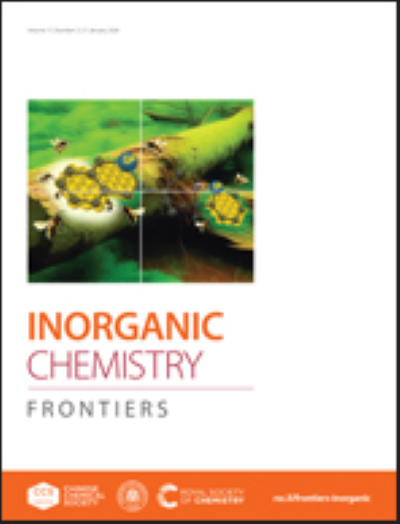Multispin superatoms: seven-nuclear rhenium clusters with unusual magnetic properties
IF 6.1
1区 化学
Q1 CHEMISTRY, INORGANIC & NUCLEAR
引用次数: 0
Abstract
Obtaining nanosized, solution-processable molecules and ions with switchable magnetic moments is crucial for the development of storage devices. In this work, two seven-nuclear rhenium cluster complexes Cs7[{Re3S4(CN)9}{Re4S4}(CN)9]·10H2O (1) and K7[{Re3Se4(CN)9}{Re4Se4}(CN)9]·15H2O (2) were prepared and comprehensively characterized. The obtained clusters with an even number of cluster valence electrons (CVE) are found to consist of triangular and tetrahedral fragments strongly bonded together by bridging inner ligands and constitute a new structural type. Magnetochemical analysis of complexes has revealed the presence of non-magnetic singlet (MS = 0) and magnetic doublet (MS = ±1) states with a temperature-dependent population. These states, according to DFT calculations, may originate from the zero-field splitted S = 1 ground state, which is quite surprising given that clusters with an even number of CVE usually possess low-spin states (S = 0) due to the delocalized nature of the frontier molecular orbitals (MOs) and the effective removal of MO degeneracy by Jahn–Teller spatial distortion of the clusters. We have also succeeded in controlling one-electron oxidation of the clusters, which results in an odd number of CVE and drives the compound into a conventional paramagnetic S = 1/2 state.

多核超原子:具有不寻常磁性的七核铼团簇
获得具有可切换磁矩的纳米级溶液可加工分子和离子对于开发存储设备至关重要。本研究制备了两种七核铼簇合物 Cs7[{Re3S4(CN)9}{Re4S4}(CN)9]-10H2O (1) 和 K7[{Re3Se4(CN)9}{Re4Se4}(CN)9]-15H2O (2),并对其进行了全面表征。研究发现,这些具有偶数个簇价电子 (CVE) 的簇合物由三角形和四面体片段组成,这些片段通过桥接的内配体牢固地结合在一起,构成了一种新的结构类型。复合物的磁化学分析揭示了非磁性单子态(MS = 0)和磁性双子态(MS = ±1)的存在,其数量与温度有关。根据 DFT 计算,这些态可能源于零场分裂 S = 1 基态,这非常令人惊讶,因为具有偶数 CVE 的簇通常具有低自旋态(S = 0),这是由于前沿分子轨道(MO)的脱局性质以及簇的 Jahn-Teller 空间畸变有效地消除了 MO 退化。我们还成功地控制了簇的单电子氧化,这导致了奇数的 CVE,并促使化合物进入传统的顺磁性 S = 1/2 状态。
本文章由计算机程序翻译,如有差异,请以英文原文为准。
求助全文
约1分钟内获得全文
求助全文
来源期刊

Inorganic Chemistry Frontiers
CHEMISTRY, INORGANIC & NUCLEAR-
CiteScore
10.40
自引率
7.10%
发文量
587
审稿时长
1.2 months
期刊介绍:
The international, high quality journal for interdisciplinary research between inorganic chemistry and related subjects
 求助内容:
求助内容: 应助结果提醒方式:
应助结果提醒方式:


